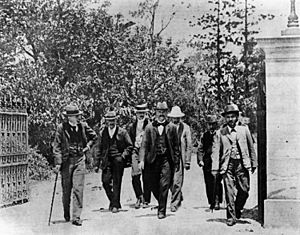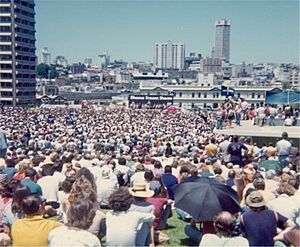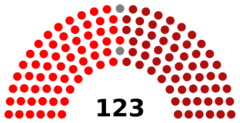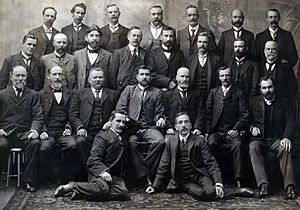Australian Labor Party facts for kids
Quick facts for kids
Australian Labor Party
|
|
|---|---|
 |
|
| Abbreviation | ALP |
| Leader | Anthony Albanese |
| Deputy Leader | Richard Marles |
| Senate Leader | Penny Wong |
| National President | Wayne Swan |
| National Secretary | Paul Erickson |
| Founded |
|
| Headquarters | 5/9 Sydney Avenue, Barton, Australian Capital Territory |
| Think tank | Chifley Research Centre |
| Youth wing | Australian Young Labor |
| Women's wing | Labor Women's Network |
| LGBT wing | Rainbow Labor |
| Indigenous wing | Aboriginal Labor Network |
| Overseas wing | ALP Abroad |
| Membership (2020) | |
| Ideology | Social democracy |
| Political position | Centre-left |
| International affiliation |
|
| Factions | Labor Left Labor Right |
| Colours | Red |
| Slogan | Building Australia's Future |
| Governing body | National Executive |
| Party conference | Australian Labor Party National Conference |
| Parliamentary party | Caucus |
| Party branches |
|
| House of Representatives |
94 / 150
|
| Senate |
29 / 76
|
| State/territory governments |
5 / 8
|
| State/territory lower houses |
267 / 465
|
| State upper houses |
65 / 156
|
The Australian Labor Party (ALP), often called Labor, is a major political party in Australia. It is known as a centre-left party. Labor is one of the two main parties in Australian politics, the other being the Liberal Party of Australia.
Since the 2022 federal election, the Labor Party has been in charge of the Australian government. They also lead governments in several states and territories. These include New South Wales, South Australia, Victoria, Western Australia, and the Australian Capital Territory. In Queensland, Tasmania, and the Northern Territory, Labor is currently the main opposition party.
The ALP is the oldest political party in Australian history that has been active without stopping. It was officially started on 8 May 1901. This happened at Parliament House, Melbourne, where the first Federal Parliament met.
The Labor Party grew from groups formed by the labour movement in Australia's colonies. These groups started running for elections in 1891. After Australia became a federation, they ran in the 1901 federal election. In 1904, the ALP briefly formed the world's first national government led by a labour party.
At the 1910 federal election, Labor made history. It became the first party in Australia to win a majority of seats in either house of parliament. Since 1910, Labor has always been either the governing party or the opposition. Australia has had 13 Labor prime ministers. They include John Curtin, Ben Chifley, Gough Whitlam, Bob Hawke, Paul Keating, Kevin Rudd, Julia Gillard, and the current Prime Minister, Anthony Albanese.
The Labor Party is often called the "party of unions." This is because it has strong connections to the labour movement and was founded by trade unions. Most Australian trade unions are linked to the Labor Party. Half of the delegates at state and national Labor conferences come from these unions. The other half are regular party members.
What's in a Name?
The word "labour" in standard Australian English is usually spelled with a "u." However, the Australian Labor Party uses the spelling "Labor" without a "u." For a while, both spellings were used.
In 1918, the federal party decided that all state branches should use "Australian Labor Party" without the "u." This change helped the party stand out. It also showed that the party was Australian, not just like other "Labour" parties in the British Empire. Some people think this spelling change was influenced by King O'Malley, who was born in the United States, where "Labor" is the common spelling.
A Look at Labor's History

The Australian Labor Party began in the 1890s. This was before Australia became one country. Many people believe the Queensland Labour Party started in 1891. This happened after a big strike by sheep shearers in Barcaldine. The ideas from this strike helped form the Labor Party.
In 1891, the first Labour candidates ran in the New South Wales election. They won 35 seats, holding the power to decide which major party could form a government. In South Australia, the United Labor Party (ULP) was also founded in 1891. By 1905, Thomas Price formed the world's first stable Labor government in South Australia.
In 1899, Anderson Dawson formed a Labour government in Queensland. This was the first Labour government anywhere in the world. It only lasted one week, but it was a big step.
Early Years in Federal Politics
When Australia's first federal parliament met in 1901, Labor candidates won 15 out of 75 seats. They held the "balance of power," meaning their support was needed for laws to pass. The Labor members formed the Federal Parliamentary Labour Party on 8 May 1901. They decided to support the Protectionist Party's government.
In April 1904, Chris Watson became Australia's first Labor Prime Minister of Australia. He was only 37, making him the youngest Prime Minister ever. His government was a minority government, meaning it didn't have a majority of seats, and it lasted four months.
At the 1910 federal election, Andrew Fisher led Labor to a big win. They formed Australia's first federal majority government. This was also the first time a Labour Party anywhere in the world had a majority government at a national level. Labor parties in other countries, like the British Labour Party, took much longer to achieve this.
In the early days, the Labor Party was made up of different kinds of people. Not just blue-collar workers, but also a doctor and even a mine owner. This shows that the party was not just for one type of person.
After World War I, many people in trade unions wanted more socialism. In 1921, the Labor Party adopted a goal to "socialise industry, production, distribution and exchange." This meant they wanted the community, not private companies, to own and control major industries. However, this goal was later softened. Federal Labor governments have only tried to nationalise an industry once, and it was ruled unconstitutional. Later, Labor governments even sold off some government-owned businesses.
The Labor Party is generally seen as a social democratic party. This means they believe in a mix of capitalism and government programs to help people. The party has always been strongly influenced by trade unions. Its policies often reflect the goals of the wider labour movement.
For a long time, from 1900 to 1940, Labor supported the White Australia policy. This policy stopped non-European people from moving to Australia. This was a common view across all major parties at the time. After World War II, the Chifley government started a big immigration program. The party's views on non-European immigration changed after 1967. Now, Labor supports multiculturalism.
World War II and Modern Times
The Curtin and Chifley governments led Australia during the second half of Second World War and the start of peacetime. John Curtin became Prime Minister in October 1941. He guided Australia through the difficult years of the Pacific War. Curtin famously said that "Australia looks to America," which helped create the strong Australian-American alliance. Curtin won a huge election in 1943 but sadly died in office before the war ended.
Ben Chifley took over as Prime Minister. His government won the 1946 election and helped Australia move into a peacetime economy. Chifley spoke about "the light on the hill," meaning Labor's goal to improve life for all people.
In 1955, the Australian Labor Party had a big split. A new party, the Democratic Labour Party (DLP), was formed. This split kept the ALP out of government for a long time.

Gough Whitlam led the Labor Party back to power in 1972 and 1974. His government made many changes, including cutting tariffs (taxes on imported goods). The Whitlam government was removed from office in 1975 by the Governor-General, John Kerr, after a political crisis. This was a very unusual event in Australian history.
After Whitlam, Bill Hayden became leader. Then, in 1983, Bob Hawke became leader and led Labor to win four elections in a row. This was a very successful period for the party. In 1991, Paul Keating took over from Hawke and won the 1993 election. Labor was in power for 13 years, their longest time in government at the national level.
After a big loss in 1996, Labor spent many years in opposition. Leaders like Kim Beazley and Mark Latham tried to win back government.
In 2007, Kevin Rudd led Labor to victory, defeating John Howard. The Rudd government was in power until 2010. Then, Julia Gillard became the first woman to serve as Prime Minister of Australia. Her government was a minority government after the 2010 election. In 2013, Rudd became leader again, but Labor lost the 2013 election.
Timeline generation failed: 1 error found
Line 13: ScaleMinor = gridcolor:200 start:0
- ScaleMinor definition incomplete.
Syntax: 'ScaleMinor = increment:.. start:.. [unit:..] [grid:..] [gridcolor:..] [text:..]'
After the 2013 federal election loss, Bill Shorten became Labor leader. The party nearly won the 2016 election. Despite good predictions, Labor did not win the 2019 federal election. This was a big surprise to many. After this loss, Shorten resigned. Anthony Albanese then became the leader without anyone opposing him.
In March 2022, Labor won the South Australian state election. This brought them back into government there.
Anthony Albanese led the party to victory in the 2022 Australian federal election. Labor formed a majority government. In 2023, Labor also won the New South Wales state election. This meant Labor was in government in all mainland states for the first time in 15 years. However, in 2024, Labor lost the Northern Territory election and the 2024 Queensland state election.
Albanese led the party to another majority government win in the 2025 Australian federal election.
Labor's National Platform
The Australian Labor Party's policies are written in its National Platform. This document is approved by delegates at Labor's National Conference, which happens every three years. The Platform is created after a lot of discussion with different groups. These include state and territory policy committees, local branches, unions, and individual party members.
The Platform gives a general idea of what a Labor government would do. It says that Labor's traditional values will always be important. It also states that Labor believes in a strong role for the national government. This is because the government is an institution that all Australians own and control through their vote.
Labor wants the benefits of change to be shared by everyone. They believe all people should have an equal chance to succeed. The government plays a key role in making things fair. This includes ensuring equal opportunities and sharing wealth more evenly. The Platform also supports equality, human rights, and democracy.
In practice, the Platform guides Labor's leaders in parliament. The specific policies for an election are decided by the Cabinet (if in government) or the Shadow Cabinet (if in opposition). These policies are then announced by the party leader.
How the Party is Organized
National Executive and Secretariat
The Australian Labor Party National Executive is the main administrative body of the party. It organizes the national conference, carries out its decisions, and guides federal members.
The party holds a national conference every three years. Delegates from state and territory branches attend. Many delegates come from trade unions linked to the party. The conference decides the party's policies and elects the national executive. It also appoints leaders like the national secretary. The current national secretary is Paul Erickson.
The national secretariat is the ALP's main office. It is managed by the national secretary. This office handles the party's administration. It also plans and runs national election campaigns.
Federal Parliamentary Labor Party
The Labor members elected to both houses of the national Parliament form the Federal Parliamentary Labor Party, also known as the Caucus. This group discusses parliamentary matters and strategies. They also elect the federal parliamentary leaders.
Federal Parliamentary Leaders
Before 2013, the parliamentary leaders were chosen only by the Caucus. The leader has always been a member of the House of Representatives. Since October 2013, both the Caucus and regular Labor Party members vote for the party leader and deputy leader.
When Labor is in government, the party leader becomes the Prime Minister. The deputy leader becomes the Deputy Prime Minister. If a Labor Prime Minister leaves office, the deputy leader steps in temporarily. The deputy prime minister also acts as prime minister when the prime minister is away. The Caucus also chooses who will be ministers, though the leader assigns their specific jobs.
Anthony Albanese has been the leader of the federal Labor party since 30 May 2019. The deputy leader is Richard Marles, also serving since 30 May 2019.
State and Territory Branches
The Australian Labor Party is made up of eight branches. These branches are in each state and territory. The National Executive plans national campaigns. However, each state and territory branch runs its own campaigns. They do this for federal, state, and local elections.
These branches include individual members and affiliated trade unions. Together, they decide the party's policies. They also elect their own leaders and choose candidates for public office.
Members join a state branch and pay a fee. Most trade unions in Australia are linked to the party at a state level. These unions pay a fee based on how many members they have. Union fees are a big part of the party's income. The party also gets money from donations and public funding.
Members are usually expected to attend at least one local branch meeting each year. However, many members are only active during election campaigns.
Members and unions elect delegates to state and territory conferences. These conferences decide policies and elect state or territory leaders. The process of choosing candidates is called preselection. Different states and territories have different ways of doing this.
The state and territory Labor branches are:
| Branch | Leader | Status | Federal MPs | Federal Senators | |
|---|---|---|---|---|---|
| New South Wales Labor | Chris Minns | Minority government | 28 | 4 | |
| Victorian Labor | Jacinta Allan | Majority government | 27 | 5 | |
| Queensland Labor | Steven Miles | Opposition | 12 | 4 | |
| Western Australian Labor | Roger Cook | Majority government | 11 | 5 | |
| South Australian Labor | Peter Malinauskas | Majority government | 7 | 5 | |
| Tasmanian Labor | Dean Winter | Opposition | 4 | 4 | |
| ACT Labor | Andrew Barr | Minority government | 3 | 1 | |
| Territory Labor | Selena Uibo | Opposition | 2 | 1 | |
Australian Young Labor
Australian Young Labor is the youth group of the Australian Labor Party. All members under 26 years old are automatically part of it. It is the main youth body within the ALP. Many former leaders and politicians were once presidents of Australian Young Labor. The current National President is Manu Risoldi.
Networks and Groups
The Australian Labor Party has many networks and groups. These groups connect members, speak up for different issues, and help create party policies. The party encourages state branches to set up these groups. They also have "policy action caucuses" for general interest groups.
Some examples of these groups include:
- Labor Environment Action Network (LEAN)
- LGBTQ wing Rainbow Labor
- Labor For Choice
- women's wing Labor Women's Network
- Labor for Drug Law Reform
- Labor for Refugees
- Aboriginal Labor Network
- Labor Enabled (for Disability Advocacy)
These groups have different names in different states and territories. They are usually divided into "equity groups" and "policy-focused groups." Equity groups focus on representing specific identities or characteristics. Policy-focused groups focus on specific issues.
| Organisation | Branches Organisation is Present in |
|---|---|
| National Labor Women's Network | Federal, NSW, QLD, Vic, WA, SA, Tas, ACT, NT |
| Rainbow Labor | Federal, NSW, QLD, Vic, WA, SA, Tas, ACT |
| Aboriginal Labor Network | Federal, NSW, QLD, Vic, Tas, ACT, NT |
| Labor Enabled | QLD, Vic, ACT |
| Young Labor | Federal, NSW, QLD, Vic, WA, SA, Tas, ACT, NT |
| Multicultural Labor | QLD, Vic, WA |
| Regional Labor / Country Labor | Federal, NSW, QLD, Vic, WA, SA, Tas |
| Organisation | Branches Organisation is Present in |
|---|---|
| Labor Environment Action Network (LEAN) | NSW, QLD, Vic, WA, SA, Tas, ACT, NT |
| Labor for Drug Law Reform | QLD |
| Labor For Choice | Tas |
| Labor for Housing | QLD |
| Labor Teachers Network | QLD |
| Business with Labor | QLD |
| Labor for Brisbane City Council | QLD |
| Australian Israel Labor Dialogue | QLD, NSW |
| Labor for the Future | QLD |
| Labor for Decriminalisation | QLD |
| Labor for Refugees | QLD, Vic |
| Labor Friends of Palestine | QLD, NSW |
| Labor Ending Homelessness Action Committee | NSW |
| Labor for the Arts (L4TA) | NSW |
| Labor for Innovation | NSW |
| Labor for Treaty | NSW |
| Labor Science Network | NSW |
| Labor Action for Multiculturalism Policy (LAMP) | NSW |
| Labor for An Australian Republic (LFAR) | Vic |
| Labor for the Wise Use of Resources | Tas |
| Tasmanian Labor Affiliated Unions Policy Action Caucus | Tas |
| Local Government PAC | Tas |
| Labor for Civil & Political Rights Policy Action Caucus | Tas |
Party Beliefs and Groups
Labor's constitution says it is a "democratic socialist party." This means it aims for the community to own and control industries. This is meant to stop unfair practices. However, this goal is balanced by other aims. These include supporting a competitive private sector and the right to own private property. Labor governments have not tried to nationalise industries since the 1940s. In fact, they have sold off some government-owned businesses.
Factions within Labor
|
Parliamentary caucus seats
|
|
|---|---|
 |
|
| Labor Left |
61 / 123
|
| Labor Right |
60 / 123
|
| Unaligned |
2 / 123
|
The Labor Party has always had different groups with different ideas. These are called "factions." Since 1989, these factions have been formally organized.
The two biggest groups are the Labor Left and the Labor Right. The Labor Left generally supports more socialist ideas. The Labor Right tends to support social democratic traditions. These national groups are also divided into smaller, state-based factions.
Some trade unions are linked to the Labor Party and also belong to these factions. For example, the Australian Workers' Union (AWU) often supports the right faction. The Australian Manufacturing Workers Union (AMWU) often supports the left faction.
Donors and Funding
In 2023/24, Labor's state and federal branches received $67.5 million in donations. Their largest donation was $1 million from Anthony Pratt. Other big donors included unions and gambling companies.
The Labor Party also gets money in ways that are not always publicly known. This can happen through "associated entities." These are groups that collect donations and then give them to the Labor Party without revealing the original source.
See also
 In Spanish: Partido Laborista Australiano para niños
In Spanish: Partido Laborista Australiano para niños
- Australian labour movement
- Labor Against War
- Socialism in Australia
- Third Way
- Tasmanian Labor–Green Accord (1989–1990)
- Australian Capital Territory Labor–Greens coalition (2012–2024)


